Iliotibial Band Syndrome Exercises
Medically reviewed by Drugs.com. Last updated on Apr 6, 2025.
What do I need to know about iliotibial band syndrome (ITBS) exercises?
ITBS exercises help strengthen the muscles around your knee and hip. Strong muscles can help reduce pain and decrease your risk for future injury.
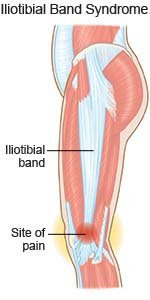 |
How do I exercise safely?
- Do not start an exercise program before you talk to your healthcare provider. You may need to wait until your swelling and pain have gone down before you start to exercise. Your provider can give you a list of ways to relieve the pain and swelling.
- Move slowly and smoothly. Avoid fast or jerky motions. This will help prevent another injury.
- Breathe normally. Do not hold your breath. It is important to breathe in and out so you do not tense up during exercise. Tension could prevent you from moving your joint in a full range of motion.
- Do the exercises and stretches on both legs. Do this so both IT bands remain strong and flexible.
- Stop if you feel sharp pain or an increase in pain. Stop the exercise and contact your healthcare provider if you have these symptoms. It is normal to feel some discomfort, such as a dull ache, during exercise. Regular exercise will help decrease your discomfort over time.
- Warm up before you stretch and exercise. This will help prevent an injury. Walk or ride a stationary bike for 5 to 10 minutes.
How do I perform ITB stretches?
Always stretch before and after you do strengthening exercises. Hold each stretch for 30 seconds to 1 minute. Repeat each stretch 2 to 3 times or as directed.
- Standing ITB stretch: Stand with your injured leg behind your other leg. Cross your front leg over your injured leg. Bend sideways toward the hip that is not injured. Stop when you feel a stretch in the hip of your injured leg. Repeat on the other side.
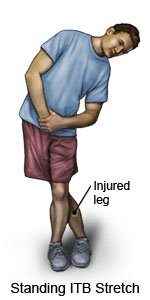
- Lying ITB stretch: Lie on your back. Bend the knee of your injured leg toward your chest. Place your hand on the outside of your thigh. Slowly pull your knee across your body. Stop when you feel a stretch in your hip and outside of your thigh. Repeat on the other side.

- Hip stretch: Lie on the ground. Place both hands on the shin of 1 leg. Pull your knee toward your chest. Repeat on the other side.
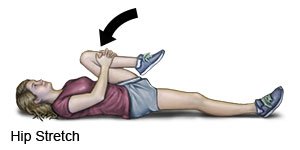
- Standing quadriceps stretch: Stand and place one hand against a wall or hold the back of a chair for balance. With your weight on one leg, bend your other leg and grab your ankle. Pull your heel toward your buttocks.
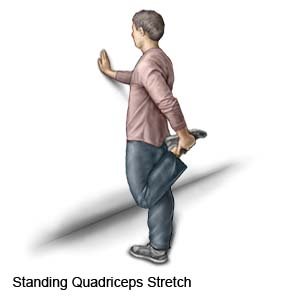
- Sitting hamstring stretch: Sit with both legs straight in front of you. Place your palms on the floor and slide your hands forward until you feel the stretch. If possible, grab your toes. Do not round your back.
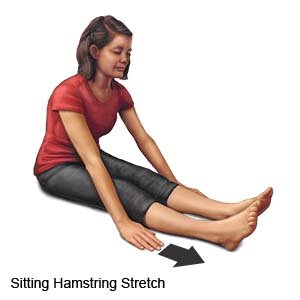
How do I perform ITB strengthening exercises?
Your healthcare provider will tell you how often to do the following exercises:
- Standing half squats: Stand with your feet shoulder-width apart. Lean your back against a wall or hold the back of a chair for balance, if needed. Slowly sit down about 10 inches, as if you are going to sit in a chair. Put most of your weight in your heels. Hold the squat for 5 seconds, then slowly rise to a standing position. Do 3 sets of 10 squats.
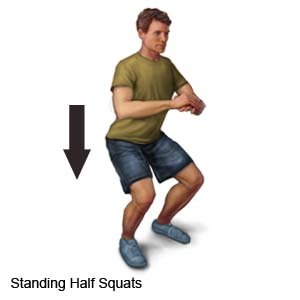
- Sitting leg lifts: Sit in a chair with both feet flat on the floor. Slowly straighten and raise one leg. Squeeze your thigh muscles and hold for 5 seconds. Relax and return your foot to the floor. Do 3 sets of 10 lifts on each leg.
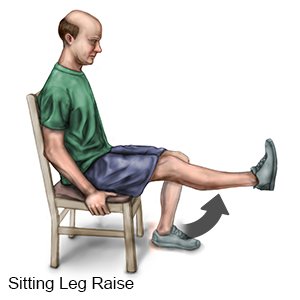
- Single leg dips: Stand on your injured leg, between 2 chairs. The backs of the chairs should be toward you. Put 1 hand on each chair. Straighten your leg that is not injured and lift it off the floor. Use the chairs to hold some of your weight. Bend the knee of your injured leg. Slowly lower your body toward the floor a few inches. Your weight should be in your heel. Hold for 5 seconds. Slowly return to a standing position. Do 3 sets of 10 on each leg.

- Standing hamstring curls: Face a wall and place both palms flat on the wall. Instead you can hold the back of a chair for balance. With your weight on 1 leg, lift your other foot as close to your buttocks as you can. Hold for 5 seconds and then lower your leg. Do 3 sets of 10 curls on each leg.
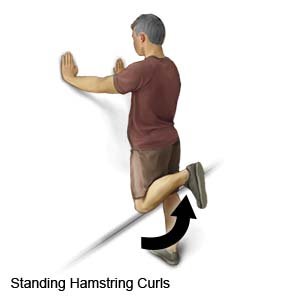
- Hip adduction: Lie on your injured side. Cross your top leg over your injured leg. Put your foot on the floor in front of you. Raise your injured leg until it touches the other leg. Slowly lower the leg to the floor. Do 3 sets of 10 on each leg.

- Hip abduction: Lie on your side that is not injured. Straighten your legs. Slowly raise your injured leg as high as you can. Keep your foot pointing straight. Hold for 5 seconds then slowly lower your leg. Do 3 sets of 10 on each leg.
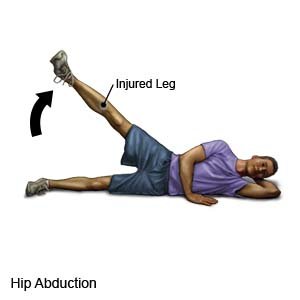
When should I call my doctor or physical therapist?
- You have sharp pain during exercise or at rest.
- You have questions or concerns about stretches or exercises.
Care Agreement
You have the right to help plan your care. Learn about your health condition and how it may be treated. Discuss treatment options with your healthcare providers to decide what care you want to receive. You always have the right to refuse treatment. The above information is an educational aid only. It is not intended as medical advice for individual conditions or treatments. Talk to your doctor, nurse or pharmacist before following any medical regimen to see if it is safe and effective for you.© Copyright Merative 2025 Information is for End User's use only and may not be sold, redistributed or otherwise used for commercial purposes.
Further information
Always consult your healthcare provider to ensure the information displayed on this page applies to your personal circumstances.
